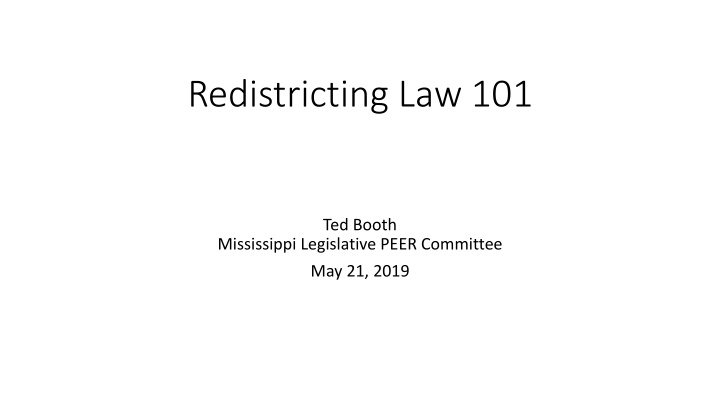



Redistricting Law 101 Ted Booth Mississippi Legislative PEER Committee May 21, 2019
Purpose of Presentation To provide an overview of the significant legal issues faced by all states in implementing redistricting.
Background • For most of our history, redistricting posed little if any legal challenge for the states. • Beginning in the 1960s, the legal environment changed dramatically creating new legal requirements and obligations.
The One-Person, One-Vote Rule-Leading Cases • Wesberry v. Sanders, 376 U.S. 1 (1964)-Population equality in congressional districts. o Districts’ populations must be as close to equal as practicable. o Unless necessary to achieve a legitimate state objective. See also Karcher v. Daggett , 462 U.S. 725 (1983). • Reynolds v. Sims, 377 U.S. 533 (1964) -Population equality for state/local legislative bodies o Gaffney v. Cummings, 412 U.S. 735 (1973), and its progeny, speak to a 10% deviation as presumptively constitutional. o But see Larios v. Cox , 300 F. Supp.2d 1320 (N.D. Ga. 2004), aff’d , 542 U.S. 947, 2004 [mem.].)
Gerrymandering • Racial gerrymandering cases have gone through two distinct phases in our legal history. o The first phase occurred during the 1990s and was marked by a judicial response to race-based redistricting marked by unusual or bizarre geography utilized to create a majority-minority district. o The newer cases tend to focus on practices other than the use of bizarre shapes, e. g. BVAP percentages, redistricting criteria. o The critical question for the courts, did race predominate in the decision to draw the district? o Strict scrutiny applies in such cases.
Gerrymandering • Partisan gerrymandering o This is a problematic area for several reasons: • courts have had difficulty finding manageable, neutral principles to guide trial courts in addressing partisan gerrymandering claims, and • in some cases, the issue of race and politics has become entwined (e.g., Cooper v. Harris). o League of United Latin American Citizens v. Perry , 548 U.S. 399). SCOTUS finds no manageable standard. Justice Kennedy notes that partisan advantage standards beg the question of how much advantage is too much. o Cases pending from Maryland and North Carolina before SCOTUS
The Voting Rights Act of 1965 • Section 2(b) of the act focuses the issue, Do members of a class of citizens protected by subsection (a) of this section in that its members have less opportunity than other members of the electorate to participate in the political process and to elect representatives of their choice . • Section 2 authorizes actions by DOJ and private parties for vote dilution.
The Voting Rights Act of 1965 • Thornburg v. Gingles, 478 U.S. 30 (1986) : Vote dilution suits must meet three threshold conditions. o it must be possible to draw a geographically-compact single-member election district where members of the minority group make up a majority of the voting-age population. o the minority group must be “politically cohesive.” o Third, the white majority must regularly vote as a block to defeat minority-supported candidates. • Plaintiffs who meet these threshold conditions must also show that, based on the “totality of the circumstances,” the minority group’s voting power was improperly diluted. Plaintiffs in these suits do not have to show that the election authorities intended to discriminate.
The Data We Use • The Census • Evenwel v. Abbott ,136 S. Ct 1120 (2016), use of resident population is acceptable • Burns v. Richards on, 384 U.S. 73 (1966), aAllowed Hawaii to adjust to remove military personnel.
State Issues • Substantive Criteria: Each state will adopt redistricting criteria to guide its redistricting authorities Examples of state adopted criteria include: o keeping political geography whole where possible--e.g., voting precincts, municipalities, etc., o compliance with the U.S. Constitution and Section 2 of the Voting Rights Act of 1965, and o incorporation of traditional redistricting principles e. g. compactness, contiguity, preservation of communities of interest, protection of incumbents, etc. Some states mandate some of these, e. g. Mississippi requires districts composed of contiguous territory.
State Issues • Process: States address process, usually by statute or committee rule. o In Mississippi, statute requires our Joint Committee to adopt a plan for consideration by the entire Legislature, o The statute leaves points of process to that Committee to decide--e.g., hearing schedules, open access to redistricting computers, software for citizen-developed plans, documenting process through Committee minutes, and confidentiality.
Major Challenges • Population shifts • The demands of the Voting Rights Act compliance and racial gerrymandering rules. • Partisan Gerrymandering?
Privilege In Federal Courts • Governed by FRE 501 • Cases touching on intentional acts, e. g. racial gerrymandering may involve plaintiffs seeking evidence of legislative purpose or motive. • In the Fifth Circuit privilege is not absolute, but determined by a balancing test. • in Jefferson Cmty. Health Care Ctrs., Inc. v. Jefferson Parish Gov ’ t the court noted: o This privilege must be strictly construed and accepted only to the very limited extent that permitting a refusal to testify or excluding relevant evidence has a public good transcending the normally predominant principle of utilizing all rational means for ascertaining the truth ( Jefferson Cmty. Health Care Ctrs., Inc. v. Jefferson Parish Gov’t , 849 F.3d 615 (5th Cir., 2017)).
Questions? • Thank you for your time and attention.
Recommend
More recommend